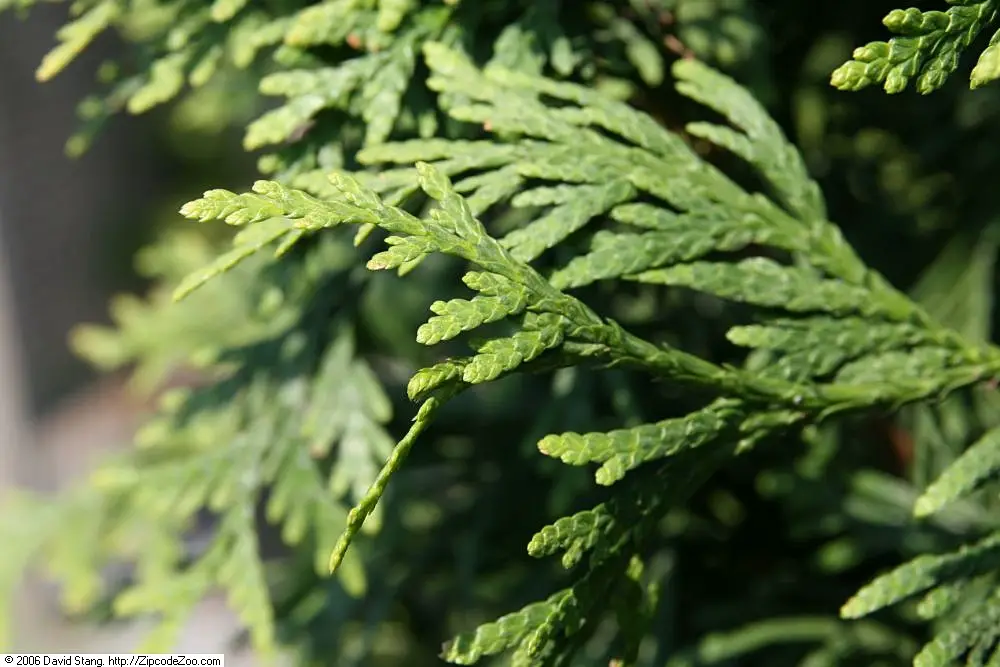The Green Giant Arborvitae (Thuja ‘Green Giant’) is a popular and fast-growing evergreen tree that’s widely used in landscapes. It’s known for its lush green foliage and its pyramidal shape, providing a stately appearance. The Green Giant is a hybrid between the western red cedar (Thuja plicata) and the Japanese arborvitae (Thuja standishii), boasting the best traits of both species.
With a growth rate of up to 3 feet per year, the Green Giant Arborvitae has become a go-to choice for privacy screens, windbreaks, and decorative hedges. Its dense foliage not only provides visual privacy but also acts as a sound barrier, making it a versatile addition to many landscapes.
What’s even more appealing about the Green Giant Arborvitae is its resilience. It’s not only resistant to diseases and pests but also adaptable to various soil types and weather conditions. This makes it an excellent option for gardeners looking for a low-maintenance, yet highly effective landscaping tree.
| Attribute | Details |
|---|---|
| Common Names | Green Giant Arborvitae, Thuja ‘Green Giant’ |
| Botanical Name | Thuja standishii x plicata ‘Green Giant’ |
| Family | Cupressaceae |
| Plant Type | Evergreen tree |
| Mature Size | 20-60 feet tall, 12-20 feet wide |
| Sun Exposure | Full sun to partial shade |
| Soil Type | Adaptable to various soil types |
| Hardiness Zones | 5-7 |
| Native Area | Hybrid (Western North America, Japan) |
Green Giant Arborvitae Care
Green Giant Arborvitae care is fairly straightforward, making it suitable for both novice and experienced gardeners. Although it’s adaptable to various conditions, providing optimal care ensures healthy growth and a lush appearance.
Planting in well-drained soil, providing adequate sunlight, and regular watering (especially in the first few years) will allow the Green Giant Arborvitae to thrive. It’s also resistant to most common tree diseases and pests, which adds to its low-maintenance appeal.
Light Requirement for Green Giant Arborvitae
Full sun to partial shade is ideal for Green Giant Arborvitae. While it can tolerate some shade, planting it in a spot with ample sunlight encourages dense, healthy growth.
Soil Requirements for Green Giant Arborvitae
Green Giant Arborvitae is adaptable to various soil types, including clay, loamy, and sandy soils. However, well-drained soil is essential to prevent root rot and other moisture-related issues.
Water Requirements for Green Giant Arborvitae
Regular watering during the first few years helps the tree establish a robust root system. Once established, Green Giant Arborvitae is moderately drought-tolerant but benefits from consistent moisture, especially in dry spells.
Temperature and Humidity
This tree is hardy and can tolerate temperatures in USDA hardiness zones 5-7. It’s also resilient to various humidity levels, making it suitable for different climates.
Fertilizer
Fertilizing in early spring with a balanced tree and shrub fertilizer can boost growth. However, this is typically not necessary unless the soil is particularly poor in nutrients.
Pruning Green Giant Arborvitae
Pruning is generally not required but can be done to shape the tree or remove dead branches. If pruning for shape, do so in the early spring before new growth starts.
Propagating Green Giant Arborvitae
Propagation is best achieved through semi-hardwood cuttings taken in late summer. Plant in a well-drained soil mix and keep moist until roots develop.
How To Grow Green Giant Arborvitae From Seed
Growing from seed is possible but typically not done by home gardeners, as it can be challenging and slow. Purchasing a young tree or propagating through cuttings is generally more practical.
Common Pests & Plant Diseases
Bagworms
An infestation can be controlled using appropriate insecticides.
Deer
Deer can be deterred with fencing or repellents.
Common Problems With Green Giant Arborvitae
Browning Foliage
Caused by too much or too little water. Adjust watering accordingly.
Winter Damage
Can occur in harsh winters. Provide a windbreak if necessary.
Pro Tips
- Plant in a row for an effective windbreak or privacy screen.
- Monitor water needs, especially in the early years.
- Choose a site with good drainage to prevent potential root problems.
- While adaptable, optimal growing conditions will promote the healthiest growth.




